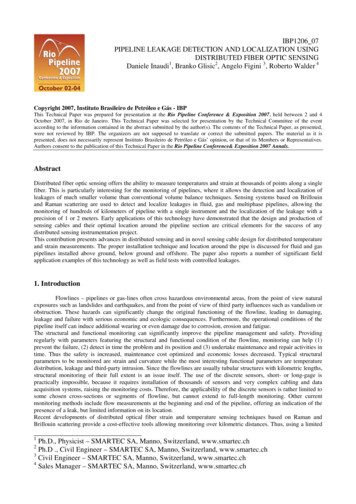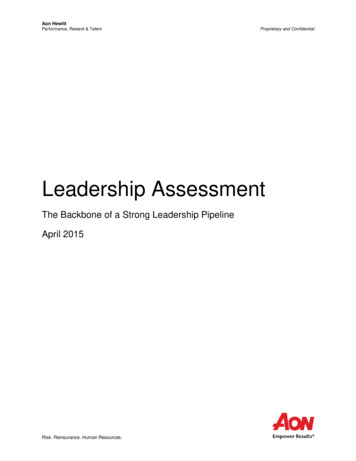
Transcription
The School Leadership Pipeline Series:Meeting Colorado's Demand for Excellent Leaders1PARTBy Kim Knous Dolan
The School Leadership Pipeline Series: Part 1Table of ContentsRecognizing the central role that school leadership plays in advancing student achievementgains, the Donnell-Kay Foundation conducted a survey of Colorado’s superintendents andleaders of Colorado’s charter management organizations (CMOs) to better understand theschool leadership landscape in our state. The goal of this project is to inform ongoing stateand district efforts to build a robust human capital pipeline to educate our state’s students.Based on the results of the survey and subsequent research, the Donnell-Kay Foundation isreleasing a series of policy papers.Introduction.3The Case for Prioritizing School Leadership .3The Colorado Context.5Key Finding I: A Shortage of Quality Candidates Survey Data. 7 Promising Research and Trends. 8Key Finding II: Current Principal Preparation is Low Quality Survey Data. 11 Promising Research and Trends. 11Key Finding III: Professional Development and Accountabilityare Levers for Change Survey Data. 14 Promising Research and Trends. 14Recommendations State.17 District.19Conclusions.20Appendix. 212
The School Leadership Pipeline Series: Part 1IntroductionThe Donnell-Kay Foundation strongly believes that recruiting, developing, and supportinghigh-quality school leaders can be a major leverage point for improving education. Over tenyears ago, the foundation helped to fund a report titled: “Principals in Colorado: An Inventory ofPolicies and Practices.” This report examined the evolving role of school leaders, pathways intoleadership, challenges associated with the job, and issues around pipeline shortages.During the fall of 2012, the Foundation surveyed the state’s superintendents and charternetwork leaders to better understand the principalship in Colorado today.Some key findings of the survey include perceptions that there is a shortage of quality leadersto run Colorado’s schools, that the quality of principal preparation is extremely poor, and thatprofessional development and accountability are levers to improve the quality of leadership.Information gathered in the survey, as well as research into national trends and promisingpractices on school leadership, serve as the basis for the report recommendations.The Case for Prioritzing School LeadershipIn recent years, Colorado has had a great focus on teacher effectiveness – with good reasongiven teachers’ immense impact on student achievement. However, if we are serious aboutteacher effectiveness, we should be serious about leadership effectiveness. While having ahigh-quality teacher in the classroom is essential for student success, to achieve teachereffectiveness at scale, schools need excellent leaders to create a cohesive culture of highexpectations and shape a vision of academic success for all students. The bottom line is thatquality school leadership is necessary for school improvement.There are many outstanding school leaders doing important work in schools across our nationand in Colorado. Yet, there are still not nearly enough quality leaders (both in the pipeline andcurrently working in schools) needed to ensure that all students achieve to their fullest potential.This may be due in large part to the demanding and ever-changing role of the school principal.3
The School Leadership Pipeline Series: Part 1The Case for Prioritzing School LeadershipToday, school principals are “asked to lead in a new world marked by unprecedentedresponsibilities where they are the front-line managers, the small business executives, the teamleaders charged with leading their faculty to new levels of effectiveness.”1 Despite being askedto do more, leaders often lack the training, autonomy and resources to do their jobs well.In an effort to ensure that our state, districts, and schools can best attract, train, support, andretain quality leaders, it is important to ask the following questions – many of which are posedin a recent Center for Reinventing Public Education (CRPE) report:21. A re principals being adequately prepared to take on the challenges that faceschools and meet the formal standards set forth by regulation?2. H ow do we ensure an adequate supply of quality leaders to run schools?And specifically, how do we get the right principals to the schools that needthem in order to have a sustained impact on improving education?3. What are the most effective policies to ensure quality and optimal operatingconditions along the entire principal pipeline?These are some of the key questions we hopeto explore and answer in this series ofpolicy-focused papers.School leadership must be a priority for Colorado.Having high quality leaders is a key leverage pointfor improving our state’s schools. Until Colorado’sgovernor, lawmakers, state and local school boardmembers, superintendents, community, and businessleaders get serious about rethinking the role of theschool principal, training candidates for success,and supporting talented people in that role, we willcontinue to have schools that languish and fail toserve our students well.1 Today, school principals are “askedto lead in a new world marked byunprecedented responsibilities where they are the front-line managers,the small business executives, the teamleaders charged with leading their facultyto new levels of effectiveness.”1Hess, Frederick M. and Kelly, Andrew P. Learning to Lead: What Gets Taught in Principal-Preparation Programs. Teachers College Record. Volume 109 Number 1, 2007.Campbell, Christine and Betheny Gross. Principal Concerns: Leadership Data and Strategies for States. Center for Reinventing Public Education (CRPE).September 2012.2 4
The School Leadership Pipeline Series: Part 1The Colorado ContextState LawsLargely because of its strong history of local control, Coloradohas not had a robust history of developing, attracting, supporting,or retaining school leaders from the state level.In recent years, policy progress at the state level has begun totake shape. Since the state is implementing important policyand regulatory levers with regard to principal preparation,program approval, and certification of school principals,increased attention is a welcome development.Most notably, S.B. 191, Colorado’s educator effectiveness reformlaw passed in 2010, requires that all principals be evaluatedannually. These evaluations are based on the seven qualitystandards for principal leadership developed by the StateEducator Effectiveness Council and the School AcademyLeadership Board.3 The Colorado Department of Education(CDE) and the Department of Higher Education (DHE) beganwork in 2011 with educator preparation programs to align theirprograms to the new principal standards and are continuingthat work.The new quality standards require principals to demonstrate: Strategic leadership Instructional leadership School cultural and equity leadership Human resource leadership Managerial leadership External development leadership Student growth leadershipSNAPSHOT OFPRINCIPALS INCOLORADO(2011)46The average age of aprincipal 80,135The average salary fora principal55%45%Percentage ofprincipals based ongender85.5%of principals are white9.6%are Hispanic or Latino2.7%are African-American9.6 yearsThe average teachingexperience of a principal19%The annual principalturnover rate6 yearsAverage time principalsserve in a principal role(with 3 of those yearsat a specific school)Source: Colorado Department of Education.The School Academy Leadership Board was created by legislation in 2008. It is charged with proposing a statewide system to identify, recruit, train, and inductqualified public school leaders; recommending changes to Colorado’s standards for school principals and induction program standards for principals; and creatinga principals’ leadership academy.3 5
The School Leadership Pipeline Series: Part 1The Colorado ContextThe past few legislative sessions have also produced a series of educator identifier laws tobetter understand educator preparation and performance. The following new laws are related toeducator quality and preparation:4 House Bill 1065 (2009): Established a unique educator identifier that enables CDE tolink teachers and principals, along with their preparation and professional development, totheir students’ outcomes.5 Senate Bill 36 (2010): Allowed CDE to track educator preparation programs and studentoutcomes so the state can identify programs that most effectively prepare educators to begreat teachers and leaders.6 Senate Bill 245 (2011): Extended oversight of educator training programs at allinstitutions of higher education, required an amount of field-based training for studentsin educator training programs, and required higher education institutions to track theplacement and performance of graduates from educator training programs in order toimprove those programs.These existing laws and structures set a good foundation for improving leadership quality.However, the work is still far from complete.State OversightBoth CDE and DHE oversee and sanction the 12 traditional principal preparation programs inthe state, which include: Adams State University, Argosy University, Colorado Mesa University,Colorado State University, Jones International University, Regis University, University ofColorado at Colorado Springs, University of Colorado at Denver*, University of Denver*,University of Northern Colorado*, University of Phoenix*, and Western State Colorado University.(Note: Programs with an “*” have the largest number of people enrolled in their principalpreparation program).In 2012, there were 859 enrollees in Colorado’s traditional principal preparation programs.There were 166 principal program completers in 2011 and 393 in 2012.7Colorado state law does allow for alternative preparation programs for principal training, andthere are currently ten in operation, with 18 enrollees. Most of the alternative route programsserve rural principal candidates through a Board of Cooperative Educational Services (BOCES)8.The State of Colorado only reviews preparation programs once every five years.Source: Colorado Children’s Campaign.The unique identifier has been established and is assigned at the time of employment. During the 2013 legislative session, HB 1220 was passed in an effort to protectindividual educator performance data, but is intended to provide greater access to aggregated data.6 With the assignment of the educator identifier, it is possible to “backward map” the performance data to the in-state program where the leader completed. CDE iswaiting on reliable data to start the tracking process.7 These numbers represent the number of candidates eligible for licensure; the state does not track who applied for and received a license. Source: Colorado Commissionon Higher Education Report: Program Results for Educator Preparation AY2011-2012 (March 2013).8 A list of current alternative preparation programs can be found here: http://www.cde.state.co.us/cdeprof/Licensure alt desigagenciesprincipal.asp.4 5 6
The School Leadership Pipeline Series: Part 1Key Finding I: Shortage of Quality CandidatesSurvey Data:Recruiting and retaining school leaders are challenges. The majority of district superintendentsand CMO leaders view recruiting and retaining excellent leaders to be substantial challenges.Nearly 50 percent of respondents identified recruiting and retaining quality principals as topchallenges and another 35 percent identified these as mid-level challenges.While these findings were similar across geographic setting, larger districts indicated greaterchallenges with recruiting quality leaders, while Charter Management Organization (CMO)leaders indicated a greater challenge with retaining quality leaders. Plus, leaders in districts withhigher state accreditation scores have higher retention rates and tend to report fewer problemsrecruiting principals.Major shortage is anticipated. District and charter leaders anticipate a major shortage of qualityleaders to lead our state’s schools, particularly our most challenging schools, now and into thefuture. Half of all respondents reported a lack of high caliber candidates for current openings,and almost three-quarters anticipate a shortage of quality candidates to fill future openings.Positions in high-poverty schools are viewed as most difficult to fill, with 63 percent of respondentsindicating a shortage.Eighty-two percent of district/network leaders reportthat a principal has left their district in the last fiveyears – with most leaving to fill other principalpositions in this state or choosing to retire. Theredoes not appear to be a large drain of school leadersto schools outside of Colorado.Formal succession planning and incentivesare scarce. Eighty-two percent of respondingsuperintendent and charter network leaders spendtime and energy identifying teachers who showleadership promise. However, only one-third haveformal succession planning systems in place.“Principals have an extremely difficult joband the stresses that come with it are notfor everyone. We may be asking them to dotoo much and being an instructional leaderis the most important aspect of their job The new educator effectiveness law willmake this more important than everbecause of the time demands for evaluationsand observations. In the long run this willimprove instruction but will also reducethe number of people that want to becomeprincipals.” Survey Respondent7
The School Leadership Pipeline Series: Part 1Key Finding I: Shortage of Quality Candidates“At the macro level, manyindividuals with strongleadership potential electnot to pursue a principal'sposition – especiallymid-career and veteranteachers – because thecompensation will beabout the same, or in somecases lower, than what theywould earn as a teacher.In high poverty schoolsand those on priorityimprovement/turnaround,these challenges are furtherexacerbated by theheightened risk of beingfired for not improvingstudent achievement.” Survey RespondentVery few districts/networks offer performance or differentiatedpay to either attract or retain quality leaders. There are a fewexceptions. In some larger districts, differentiated pay is offered toprincipals working in both turnaround and alternative schools. Afew charter networks report providing performance pay for studentachievement gains.Promising Research and Trends:DATARecently there has been a national call to action for states to trackand use data for clarity around leadership needs. In addition to theCRPE report, a recent National Conference of State Legislatures(NCSL) report on school leadership laws adeptly points out,“Robust data systems can facilitate successful recruitment andselection processes. States can access, use and analyze data totrack the supply and demand for principals, project impendingretirements, and track principal preparation program enrollmentand completion rates.”8A 2013 report by the George W. Bush Institute’s Alliance toReform Educational Leadership (AREL), provides a useful guidefor states wanting to take a more active and data driven role in supporting the supply ofhigh-quality school leaders.9 Without strong data systems and information, the report concludesit is challenging to approve effective principal preparation programs, establish standards forreceiving and keeping a license, and monitor principal quality.It is critical for states to know which schools and districts are having trouble finding and keepinggreat school leaders and why: retirements, hard-to-staff schools, location, or other factors. Thesequestions can begin to be answered with better and more intentional data collection.ROLE & FLEXIBILITYAnother emerging national trend is the rapidly changing role of school leadership and howstates and districts are working to create the right policies and practices to keep up. In anEducation Week article, “Turnover in Principalship Focus of Research” (2009), then Universityof Texas researcher Ed Fuller provided insight into the principalship, saying, “We think the jobhas outgrown the ability of one person to handle it. Nobody is staying long enough to makeconnections or shepherd reform through.”8 Shelton, Sara. Strong Leaders, Strong Schools: 2010 School Leadership Laws. National Conference of State Legislatures. 2011.Briggs, Kerri; Cheney, Gretchen Rhines; Davis, Jacquelyn, and Kerry Moll. Operating in the Dark: What Outdated State Policies and Data Gaps Mean for EffectiveSchool Leadership. AREL, 2013.9 8
The School Leadership Pipeline Series: Part 1Key Finding I: Shortage of Quality CandidatesBuilding aLarge Corps ofWell-QualifiedCandidates for thePrincipalship Create job descriptionsthat clearly spell outwhat principals needto know and do to drivebetter instruction.In order to attract talented individuals to the profession, statesand districts are rethinking the role of the school principaland how it can be made more inviting and sustainable. Newleadership models, such as co-leadership and teacher leadershipmodels, will be examined in-depth in a later paper of this series,as this is particularly important for hard-to-staff schools, includingturnarounds and high-poverty schools.Efforts to increase the flexibility and autonomy of principalsand leadership teams are key tactics to making leadership rolesmore attractive. In Colorado, innovation schools and charterschools provide school leaders more autonomy with regard tostaffing, use of time, budgeting, curriculum, and otherresponsibilities. Improve “pre-service”principal training. Establish selectivehiring proceduresthat identify the mostpromising futureleaders and matchthem to the rightschools. Ensure thathard-to-staff schoolsget top-qualityleaders.Source: The Wallace Foundation.INCENTIVES & HUMAN CAPITALIn addition to rethinking the role of the school leader, policies and practices that incent qualitypeople to enter and remain in the profession are also being considered.Many states have opened up the profession to non-traditional candidates10 seeking to leadschools. However, there are still some limiting state licensing requirements in Colorado thatrequire documented evidence of three or more years of full-time successful experience workingas a licensed or certified professional in a public or non-public school in the U.S. to lead atraditional public school (see sidebar, page 10).10 Non-traditional candidates refers to individuals with no-prior teacher or school experience who may come from sectors outside education.9
The School Leadership Pipeline Series: Part 1Key Finding I: Shortage of Quality CandidatesAs CRPE points out, states might “consider a limited numberof input requirements (for example, background checks andbachelor’s degrees) and let districts develop interview screensthat seek out particular beliefs and orientations (for example, abelief that every child can succeed, a focus on results, andevidence of persistence), instructional knowledge, ability touse data, and leadership skills to inspire but also critiqueperformance.”12Below are other examples of policies and practices that statesand districts are employing to ensure a pool of qualified schoolleaders: States such as Indiana and Tennessee have partnered withNew Leaders for New Schools to pilot a training toolkit forprincipal managers and superintendents on how to hiregreat school leaders. The state superintendent is thenexpected to certify school leaders hired through thismethod. Chicago public schools has secured millions in privatephilanthropy to provide bonuses for principals whodemonstrate effectiveness (through student growth as wellas qualitative evaluations). They are also screening newcandidates through “day in the life” simulations designedto assess their ability to manage real-life scenarios. Maryland now requires the State Board of Education toestablish a program to support locally negotiatedincentives (financial or other incentives) for highlyeffective classroom teachers and principals to work inhard-to-staff schools.13CDE PrincipalLicensingRequirementsTo become a licensedprincipal in a Coloradopublic school,11 one must: Hold a bachelor’s orhigher degree from anaccepted, regionallyaccredited institutionof higher education. Complete an approvedprincipal preparationprogram at an acceptedinstitution of highereducation or anapproved alternativeprincipal program. Provide documentedevidence of three ormore years of full-timesuccessful experienceworking as a licensedor certificatedprofessional in apublic or non-publicelementary orsecondary school inthe United States. Achieve a passingscore on the PLACEprincipal contentexam.Source: C olorado Department ofEducationNote: Charter school principals are not required to have a principal’s license. A 2009 CDE Report: Charter Leadership in Colorado, reported that about 50% of charterschool principals hold a CO principal license.12 Campbell, Christine and Betheny Gross. Principal Concerns: Leadership Data and Strategies for States. Center for Reinventing Public Education (CRPE).September 2012.13 Shelton, Sara. Strong Leaders, Strong Schools: 2010 School Leadership Laws. National Conference of State Legislatures. 2011.11 10
The School Leadership Pipeline Series: Part 1Key Finding II: Current Principal Preparation is Low QualitySurvey Data:Principal preparation was identified as lowquality. Only one in ten district/CMO leadersbelieve new principals are well-prepared for theirjobs. Less than five percent felt that principalpreparation was “outstanding” in preparing leadersfor instructional leadership and student growth.“We need to revamp the credentialingprocess in universities and colleges. It isoften commented on that the easiestmasters degree is in administration.We need more rigor and more focus onwell-rounded principals. Perhaps greaterinternships and oversight of theprobationary period ” Survey RespondentSpecialized training for working in various typesof schools (e.g. high-poverty schools, turnaroundschools, alternative schools (AECs), new schools, or innovation schools) is viewed as important,but not extremely important. Specialized training for working in high-poverty schools receivedthe highest importance rating of 60 percent, with turnarounds coming in second with a50 percent importance rating. Only 4 percent of respondents believed principals were trained“extremely well” or “well” to work in high-poverty schools.Although superintendents and charter network leaders cited specific preparation programs thatthey judged to be the best provider of quality principal training, very few of them actually usedpublished data or formal evaluations to make such judgments. Half rely on personal experience.Principal preparation for key skills does not match need. Instructional leadership and studentgrowth were identified as the most important school leader competencies, with 75 percent ofrespondents indicating they are extremely important. Unfortunately, superintendents/CMOleaders reported that the performance and preparation for these competencies do not match theneed. Only one in five district/CMO leaders felt the performance of today’s principals was“outstanding” (top rating on a five point scale) in these extremely important competencies.“ Too many [prep] programsare focused on theory and failto help students make theconnection between theoryand reality. Theory is only that,a theory, until it is put intopractice and made to workin any given situation based onthe circumstances.” Survey Respondent14 Promising Research and Trends:Research and anecdotal evidence reveal that, in general, bothteacher and principal preparation programs are of poor quality.In 2005, Arthur Levine, the former President of ColumbiaUniversity’s Teachers College, published an exposé on educatortraining programs across the nation writing that the majority ofleadership-based training programs “have turned out to be littlemore than graduate credit dispensers.”14Levhine, Arthur. Educating School Leaders. The Education Schools Project, 2005, 31.11
The School Leadership Pipeline Series: Part 1Key Finding II: Current Principal Preparation is Low QualitySeveral other studies since that time go on to confirm such observations. One study reviewed thecontent of the nation’s principal preparation programs and revealed that“just 2 percent of the 2,424 courses addressed accountability in the context of schoolmanagement or school improvement and less than 5 percent included instruction onmanaging school improvement via data, technology, or empirical research. ” 15In their report, “A New Approach to Principal Preparation,” the Rainwater Leadership Alliance(RLA) features top-notch leadership training programs.16 All of the RLA programs are “highlyselective and establish clear criteria and rigorous processes to evaluate applicants.” 17 They citethe following key elements for quality principal preparation (with a continuous cycle of programevaluation):1. Developing a Principal Competency Framework2. Building a Candidate Pool3. Selecting Candidates4. Training and Developing Fellows5. Supporting PrincipalsThe AREL at the Bush Institute also has created a collaborative network of principalpreparation programs, each committed to the Institute’s nine competency standards whichinclude, “implementing a more rigorous principal selection process, targeted principal training, ameaningful clinical leadership experience, and continuously evaluating graduates’ effectivenessin raising student achievement.” 18 Get Smart Schools in Colorado is one of AREL’s featuredleadership training programs doing promising work training leaders to work in autonomous,turnaround, and high-poverty schools.Many charter schools and CMO networks (similar in size to many rural districts and BOCES)create their own year or two year-long principal training programs. This is an economical trainingpath and preferable to ensure a seamless transfer of the organization’s core values, mission, andculture. Sometimes this practical training year in an administrative support role is supplementedwith university coursework for licensure purposes, but not always. The practical learnings receivedduring this “resident” year often prove invaluable for developing future leaders. Below are somelocal and national models with strong internal leadership training programs: Achievement First Denver School of Science and Technology KIPP Fisher Fellowship Strive Preparatory SchoolsHess, Frederick M. and Kelly, Andrew P. Learning to Lead: What Gets Taug
5 The School leaderShip pipeline SerieS: part 1 3 The School Academy Leadership Board was created by legislation in 2008. It is charged with proposing a










